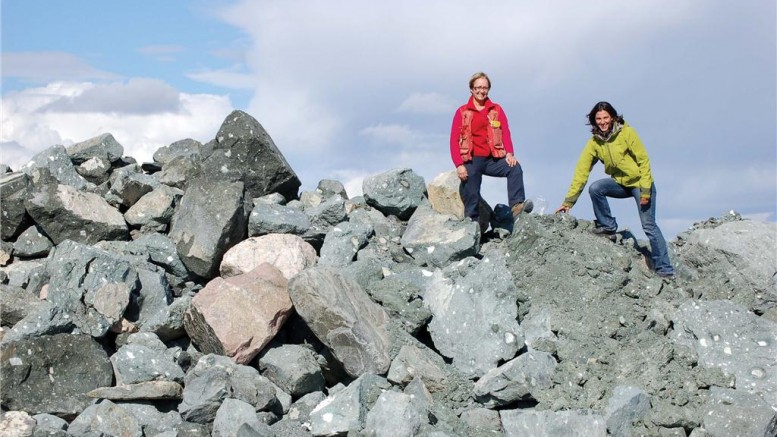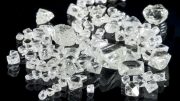The Northern Miner headline in September 2005 proclaimed the exciting news: Tahera Diamond’s 100%-owned Jericho diamond mine would be Canada’s third diamond mine, and the first in Nunavut.
And, indeed it was, beginning commercial production in July 2006. However, from the start, the mine was fraught with problems. From the grade, to milling and processing issues, and carat value to exploration, nothing seemed to work as predicted, anticipated or projected.
Canadian junior Tahera Diamond obtained bankruptcy protection in 2008, and the Jericho mine ceased operations that June and was placed on care and maintenance, making it Canada’s first failed diamond mine.
But even with that unlucky pedigree, another Canadian junior, Shear Minerals (SRM-V), believes the asset could serve as a launching pad for it to join the elite group of Canada’s diamond producers.
In July, Shear Minerals announced it was buying the Jericho mine, processing facilities and the supporting exploration assets for
$2 million plus an aggregate of 80 million shares and a 2% royalty to Caz Petroleum, the secured creditor of Tahera. As part of the purchasing process, Shear closed a $13.1-million financing at the end of August, issuing almost 140 million shares.
“What really got us vested in making the deal happen was. . . the upside that we could see at the project, the sunk costs in that existing infrastructure, and also a clear path (regarding) how we can improve upon the past operation,” says president and CEO Pamela Strand. “We needed all of those three things to convince us on the acquisition.”
Shear Minerals has been an integral part of the Canadian diamond exploration scene since 1997. Led by Strand, Shear was one of a number of Canadian diamond exploration juniors founded in the years following the discovery of diamonds in the Northwest Territories (1992), and opening of the Ekati (1998) and Diavik (2003) diamond mines. These juniors targeted investors keen to ride the diamond wave, and the strong rough diamond market. They focused primarily on promoting Canada as the global diamond producer of the future.
Shear concentrated its efforts on the Churchill region of Nunavut, and enjoyed a number of initial successes. However, there were no major discoveries — nothing that excited the market or investors. The company developed a positive reputation in Nunavut, strong exploration expertise in the region and a core of supportive investors, mostly on the retail side, with limited involvement from institutions. Shear ventured into other diamond districts, with properties in the Pelly Bay region, in the Slave Geological Province and in Alberta, although none of the properties are at the core of the diamond activity in these regions. While Shear’s share price has jumped above $1 several times, it spent most of the middle part of this decade in the 40-50¢ range. Since the market crash of 2008, its share price has been mired between 5¢ and 10¢.
As with all sectors, the diamond industry suffered during the global financial crisis. The diamond exploration sector, much of it based in Canada, was devastated. Globally, almost all rough diamond producers either closed their mining operations or reduced production significantly. When rough diamond trading activity began to pick up in early 2009, rough diamond prices were 50% lower than they had been six months earlier.
As many companies did, Shear reduced spending and activity during the financial crisis. However, during that time, management did not sit idle, but instead rethought the company’s strategy. Once the diamond markets recovered, and the financial markets turned around, would it be more of the same? Or was this an opportunity to consider a company-transforming move?
Meanwhile, Tahera Diamond and the Jericho mine were working their way through the bankruptcy courts. While the Jericho mine had been unsuccessful from the beginning, the operation, 420 km northeast of Yellowknife, N.W.T., was not without value. The mine infrastructure was licensed and built. The open pit was developed, and mining equipment in place. A 2,000-tonne-per-day diamond processing facility, maintenance offices and other support facilities, including a fuel farm, were complete. Accommodation and office facilities for 225 workers were ready for use. It contained significant in-situ resources and stockpiles, and it was located in the middle of Canada’s premier diamond-producing region.
In addition to the physical infrastructure assets, Tahera had accumulated considerable tax losses. It was those tax losses that attracted the interest of Caz Petroleum.
Caz obtained the tax losses from Tahera, and found itself with a defunct diamond mine. It then invested more than $1 million in a post-mortem of Jericho, reviewing all aspects of the operation — from the geology, to the feasibility study, the mine plan, mining operations, diamond distributions and design and operation of the processing facility. The reviews not only identified numerous issues, problems and questions, but also proposed solutions and options to explore in order to make the mine economically viable.
Caz then went looking for a diamond company to purchase the operation and the critical post-mortem reports. After reviewing the reports and the assessments that had been completed, Caz saw this transaction not just as a sale, but as a strong investment opportunity if the right team could be found to move Jericho forward. The right team would be a diamond exploration company with excellent diamond geology expertise, strong management experience and a good relationship with, and understanding of, the people of Nunavut.
Meanwhile, Strand and the rest of Shear’s management and directors had been reassessing the company’s direction. They had identified Jericho as an opportunity to move Shear from a junior exploration company with decent assets to a company on the verge of being a producer. However, they needed someone with the experience and expertise to raise and attract the necessary financial support. Enter Julie Lassonde.
Lassonde brought engineering expertise as well as years of corporate risk management and financing expertise to the table. The former president of Garson Gold, which was taken over by Alexis Minerals (AMC-T) earlier this year, she was looking for new challenges, and for her, the timing seemed right for diamonds.
“The world diamond supply going forward, without any further major discoveries, is expected to be flat. This, just as demand for the gemstone is increasing, resulting in a recent return to pre-crash prices for the rough,” explains Lassonde, Shear’s executive chairman. “The general consensus is that rough prices will increase five per cent year-on-year for at least the next five years. I can’t imagine a better time to be involved in the Canadian diamond industry.”
The timing was good for Shear, too. By late 2009 and early 2010, the rough diamond markets had begun to recover from the financial crisis. While the lag of polished prices behind the recovery in rough prices continues to be a short-term concern, the medium to long-term outlook for diamonds is extremely positive. There have been no major diamond mine openings since Diavik in 2003, and there are no significant world-class diamond mines in the development pipeline. Combined with increased activity and interest in the financial markets, this allowed Shear to bring all the pieces together this summer.
The new Shear
The new Shear still has strong connections to Nunavut, and diamond geology expertise, but has added technical and financial expertise, and strong support from institutional shareholders. Caz Petroleum is now the largest shareholder with just over 17%, and is looking forward to the potential rewards if the Jericho property can be turned around.
Jericho’s geology, location and the associated costs of operating in the north haven’t changed. Nor have the diamond market and prices improved significantly since it was in operation. Yet it has the potential to be a company-transforming asset. The geology is now better understood, as are problems with the mining operation and processing facilities. There are still deficiencies, but Shear’s management team feels it understands them and is committed to addressing them before proceeding.
“We believe our biggest challenge will be realizing Jericho’s true full potential,” Strand says. “Shear has set a clear path forward to reassess the economics, the geological resource and the milling/engineering. We are excited by the future possibilities that Jericho presents for Shear.”
Jericho still holds indicated resources of 1.8 million tonnes grading 1.06 carats per tonne for 1.9 million carats and inferred resources of 1.7 million tonnes grading 0.65 carat per tonne for 1.1 million carats.
In the short term, the company expects to have the water licence for the operation renewed by the end of the year. Meanwhile, exploration work on the property is planned for 2011. The Jericho kimberlite has a total of five lobes, with most of the current resource located in the Central and North lobes. Shear’s initial focus will be on the higher-grade Central and North lobes of the Jericho kimberlite complex, with the intention of improving reserves and grade through deep drilling and bulk-sampling programs.
“Even though we believe there’s great opportunity to make a nice profitable operation with what we have, we’re in it to make it bigger and better,” Strand says.
That includes lengthening the mine life at Jericho, which a previous feasibility study had pegged at eight years.
The upside comes not only from further work at the Jericho kimberlite complex, but also from five additional known kimberlites, five unresolved kimberlite indicator trains and two kimberlite float discoveries on the property.
Over the next 12 months, the recommendations and suggestions proposed in the post-mortem reports will be assessed, tested and verified. Plans to increase the processing plant availability and efficiency will be explored. These include reducing the handling of the ore material, improving crushing and sorting operations to improve recovery rates, and improving diamond recovery systems. Strand says the company should have a “game plan” for next year in place by mid-November.
At the mine site, there is a stockpile of low-grade ore (included in the indicated resource) containing an estimated 65,000 carats of diamonds in 156,000 tonnes grading 0.42 carat per tonne. But there’s another very high-grade stockpile of “coarse rejects” that is not part of the resource. Strand estimates that stockpile, which had been milled, but not processed properly, at about 20,000 tonnes.
“This is very high-grade material, largely made up of mantle nodules and concentrates that was very difficult to process because of the hardness and the rounded nature of these nodules,” Strand says. “We see that as huge upside because that currently isn’t in our resource, and material like that can add substantial grade in your recovery circuit.”
Whether Shear will be able to process this ore and extract the diamonds will depend on the successful implementation of the improved crushing and sorting facilities, but Strand says it’s nothing that hasn’t been successfully handled at other diamond mines.
At the other end of the economic viability question is, of course, the value of the diamonds. Tahera marketed the initial Jericho production under an agreement with Tiffany & Co. (TIF-N). Tiffany purchased the diamonds it wanted and sold the rest into the open market for a fee. Diamond valuations pre-mining, and during the mining operation ranged between US$75 and US$90 per carat. These valuations will need to be updated, and revised based on the new bulk sampling.
Shear still needs to add mine development expertise, diamond mining and processing experience, and to explore the options and opportunities for the marketing of the production. The transition from an exploration focus to a development and production focus is not an easy one.
The purchase and financing have resulted in a significant increase in the number of issued and outstanding shares (now more than 421 million), so Shear anticipates proposing a share consolidation, not to exceed 10:1, at its next annual general meeting.
Shear hopes to have a new resource estimate and economic assessment for Jericho next fall. That will be a critical decision point. If the decision is positive, then Jericho could be back in production by the summer of 2012, and Shear would be faced with the pleasant decision of how to market and sell rough diamonds.
In the race to be Canada’s next diamond mine, Jericho has, once again, moved to the front of the pack.
— The author is a diamond consultant based in Saskatoon, Sask., and can be reached at mirving@sasktel.net.





Be the first to comment on "Jericho purchase marks change in strategy for Shear Minerals"